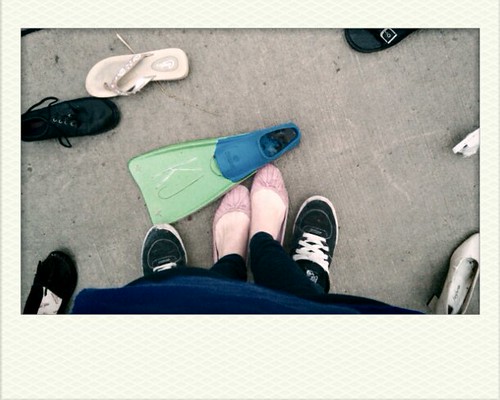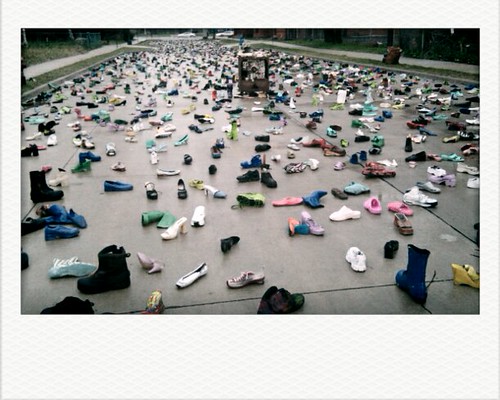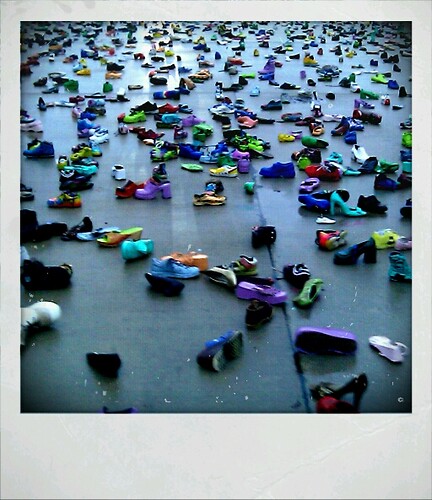
For years, my interest in Detroit’s ruins and restructuring has drawn me into an unparalleled world. In an attempt to preserve the much forgotten history and culture of the equally elapsed metropolis, I explore the city with fresh eyes and an open mind. Especially drawn to the city’s underground art scene, trips downtown provide an escape from an uninteresting, middleclass suburbia.
Eastern Market, Belle Isle, and antique stores like John K. King Books are among my favorite places to explore; nonetheless, downtown adventures produce more excitement when letting the city find you and not the other way around.
Last week, while driving to help a friend hang artwork in a gallery space downtown, I came across a woman, surrounded by people, who had collapsed in the middle of Woodward Avenue. It’s unforeseen as to what you may find in Detroit. Unusual? Yes, but surprising? Not particularly. The same day, I stumbled upon a colorful roadblock, scattered with “lost soles”. The style of shoes ranged in scuba flippers, baby slippers, high heels, snow boots, and sandals galore. It had Tyree Guyton’s name all over it. The street was drowning in a sea of shoes, which Guyton encouraged spectators to walk through as long as long as the installation remained undisturbed.

Although caught off guard, the content and medium of the installation proved redundant. Some call Guyton the founder of Detroit’s ‘street art’ movement, but recently, Guyton has fallen off the radar. Guyton and his grandfather constructed The Heidelberg Project in 1985. In its heyday, The Heidelberg Project was a controversial topic in the art world. Mixed reviews ridiculed Guyton for turning trash into sculpture, while others praised him for challenging viewer’s expectations of what art actually is.
Today, The Heiedelberg Project is wearing with age, and Detroit’s expanding art scene is making room for new artists. Last Thursday proved Guyton is back; however, not only is his work reinstituting recycled materials, but his ideas are reused as well.
Walking through the spray painted jumble of shoes was nothing less than eerie. I couldn’t help but wonder whom the abandoned shoes once belonged to, how long it took Guyton to collected such bulk, and whether the previous owners were alive. Each pair was displaced, representing the homeless of Detroit. Many of the shoes reflected trends from the past (platforms, jellies, and light up sneakers),which only widened the gap between where I stood and the empty slots in front of me. Like Guyton, who’s living in the past, the project resurfaces unsettling feelings of time.
Guyton’s obscure “modern art” attempts to stir social debate; however, delivering the pressing issue in old packaging is like beating a dead horse, hopeless. Perhaps Guyton is nostalgic for his glory days, and I can’t deny that his work once proved that beauty can come from decay. The Heidelberg Project originally produced a greater message for the city of Detroit by transmitting the idea that: amidst the city’s ruins, reconstruction is viable.
Peculiarities like the woman in the street and the road block-mixed with adrenaline-make downtown adventures unlike anything else. Unexpected turns and twists catch you by surprise but equally lure you in. Art produces a similar effect. Today, Detroit artists ought to produce works of art that play an active role in the rebuilding of Detroit. Newness is needed and the medium of art can reconfigure old distortions of the city. Detroit is often misrepresented but art and new vision can reshape the city’s broken image.



I suppose I can understand your first-blush impulse to paint a “been there, done that” perspective on the Guyton installation on Edmunds. Yet, which other local artist is producing easily accessed large-scale vignettes worthy of contemplation about Detroit and its people? Sestock comes to mind for scale, but you have to search him. Shall we contemplate the Barry McGee thow-up on MOCAD? 300+ cans of silver and black aerosol spent on Woodward are trendy but have little meaning here (other than art elites paid a street-art all star to come here and impart some outsider cred to their facade). Guyton’s medium (shoes) can be seen as old-school, sure. The message is the same because not much has really changed for the better for people of my city in this throw-away culture. When I came upon the instalation, as you did, I could not help but think about the folks who had worn those shoes, their lives, their stories. Maybe they were raptured right out of their footwear, and we’re the sorry remnant left behind to walk in skinny jeans and pointy shoes. I am reminded of the Angelou line “and still I rise.” So does Guyton.